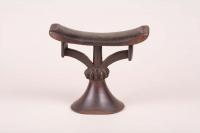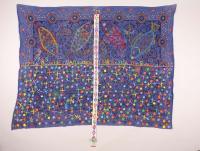Posted on September 17, 2009

How is an object valued?
For want of a better word, the collection is called 'traditional' because it is understood to have been created within and for communities that, to a lesser or greater extent, follow authentic African ways of life (what is authentically African is the subject of another discussion). It is made up of objects from southern Africa dating back some 150 years with others made during the twentieth century, the most recent within the last 10 years. It would seem logical to define these objects as craft since they are all handmade and are mostly functional including milk pails, beer vessels, beaded clothing, baskets and pipes. But, although they fit the definition of craft, they are not now classified as such nor were they in the past. Their originating communities made no distinctions between art and craft - objects were valued for their efficacy, their beauty and as indicators of identity, status and wealth. Many were treasured items linked to the ever-present ancestors. However, when they entered Western aesthetic categories they were ambivalent - neither properly art nor properly craft but rather something different.
Before the late 1970s, this material was absent from the Johannesburg Art Gallery (JAG) holdings. JAG, along with other art galleries in the country, collected paintings and sculpture created according to Eurocentric standards. Because it lacks the dramatic carved masks and striking anthropomorphic and zoomorphic sculpture of West and Central African traditional southern African material did not even make the grade as 'African art' as it failed to excite the sensibilities of European modernists. With more in common with east African art, it consists mainly of small-scale personal objects, created in a sophisticated but restrained aesthetic. It was not considered 'Art' in the Western sense for other reasons including the erroneous notion that no individual creative geniuses could be assigned to works, objects were assumed to be repetitive copies of 'traditional' forms and the genre appeared to lack intellectual, spiritual and contemplative dimensions.
From the time of the Enlightenment, European classificatory systems have determined the status of material culture in western academic and museological institutions. Decontextualised from the social systems that gave them meaning, and with the racial prejudices of South African officialdom dominating early to late twentieth century institutions, traditional objects from southern Africa became markers for the inequality of races. Declared to be the production of pre-modern societies it was relegated to the realms of natural history and ethnography. Today the situation has changed somewhat. However, it is not the objects that have changed but the value systems that determine the way we categorise the heritage of South Africa's diverse cultures.
As the twentieth century progressed and the boundaries of Western art practice became more permeable with performance art, conceptual art and the acceptable range of materials widening, so a path was opened for material previously excluded. But, more critically, fundamental political changes generated a need to respect the cultures of all South Africans. In the late 1970s some traditional objects began to make the move from ethnological and natural history institutions into national and civic art galleries (not all made it across the great divide and the majority remain in these former institutions). In a move to redress the injustices of the past, and to be seen to be transforming, some of South Africa's major art galleries sought out 'traditional' collections that honoured an African past. These collections are now valued as National Heritage.
While the material still does not fit comfortably within the category of 'art', there is a growing appreciation that many of these objects are the bearers of 'significant meaning' and possess spiritual and transcendent qualities. This gives them the contemplative dimension that helps to define/negotiate their position within the art gallery. In Western ontological systems a vessel from which to drink beer could not be considered art but, within African systems of belief, many functional objects facilitate connections to departed spirits thus giving them 'enhanced' value. Furthermore, when looking through the JAG collections it becomes evident that, in the past and today, specialist carvers, potters, metal workers and weavers were known and revered. Many have left a distinctive mark in the material archive.
Contemporary resonances with the past

Having enjoyed a change of status, this body of objects is now influencing contemporary art and craft production. Potter Rebecca Matibe had produced functional craft ware for her community for many years. With the precedent of similar 'traditional' objects now in art galleries, her talent is recognized and her ceramic vessels sought as art and her work celebrated as national heritage. Similarly, Nesta Nala's work is now part of many of our national collections. These potters made functional 'craft' for their communities before shifting in response to changing attitudes towards 'traditional' artwork. Had the status of the 'traditional' collections not changed, would their work have had a different developmental trajectory?
Neither Ian Garrett nor Clive Sithole ever made functional ware - they both create extraordinarily fine ceramics that have a strong association with traditional pottery. Their innovations are made within a secular context but their references to the 'traditional' enhance their work through its association with the 'authentic'.
Basketwork created for use by rural black communities had largely died out by the early twentieth century but, by the 1970s, the Vukani Project at Rorke's Drift in KwaZulu-Natal had sparked a rebirth in production catering for a growing urban and export market. Basketwork is now divided between craft items such as mats and waste paper baskets for urban homes and art objects by weavers such as Sabina Mtetwa, Vina Ndwandwe and Beauty Ngxongo. Drawing on traditional methods of harvesting materials, dyeing and weaving, these three basket makers (and a growing number of others) make woven forms that are non-functional and aesthetically innovative, destined for collectors' homes and art galleries.
Matibe and Nala have worked from the traditional into the contemporary. Garrett, Sithole, Mtetwa, Ndwandwe and Ngxongo work in the contemporary and reference the traditional. Had the traditional collections not undergone a shift in status how would we place the work of these artists?
by Nessa Leibhammer
Curator: Traditional Southern African Collections
Johannesburg Art Gallery
Photos courtesy Johannesburg Art Gallery:
Xikhigelo / headrest
Xitsonga-speaking carver
Late 19th/ early 20th century
Wood
16 x 18.4 x 9cm
Collection: Johannesburg Art Gallery
Accession number: 1987.03.33
Nceka / beaded wrap
Letisa N'wa-Hlengani Thirayisa Mashawu
Mid 20th century
Textile, glass beads, thread, snuff-tin
131 x 144cm
Collection: Johannesburg Art gallery
Accession number: 1994.01.09